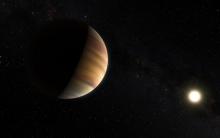Listen to today's episode of StarDate on the web the same day it airs in high-quality streaming audio without any extra ads or announcements. Choose a $8 one-month pass, or listen every day for a year for just $30.
You are here
Beta Pegasi
With summer just about ready to give way to fall, one of the signature star patterns of the new season is climbing into prominence in the evening sky. The Great Square of Pegasus is in the east as night falls. It’s tilted a bit as it rises, so it looks a bit more like a diamond than a square.
The jewel at the top of the diamond is known as Beta Pegasi. It’s a red giant — an old, bloated star that shines reddish orange. That color isn’t visibile to the unaided eye because the star is relatively faint — mainly because it’s about 200 light-years away. But the tint should be easy to see through binoculars.
A star’s color is the result of its surface temperature. Hot stars are blue-white, while cool stars are orange or red. Beta Pegasi is thousands of degrees cooler than the Sun. That’s because the star is nearing the end of its life. Changes in its core have caused its outer layers to puff outward, so the star is almost a hundred times the Sun’s diameter. That caused the gas in those layers to get cooler — and redder.
The change in temperature also produces a change in the type of energy the star radiates into space. Stars like the Sun produce most of their energy at visible wavelengths. But most of the light from Beta Pegasi is in the infrared — wavelengths that are too long for human eyes to see. When you add all the wavelengths together, Beta Pegasi shines about 1500 times brighter than the Sun — a red jewel sparkling across the galaxy.
Script by Damond Benningfield




